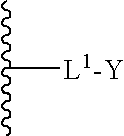Production of Oligosaccharides By Microorganisms
a technology of oligosaccharides and microorganisms, which is applied in the direction of fertilization, etc., can solve the problems of high cost or difficulty in obtaining nucleotide sugars, which are used as substrates for many sialyltransferases, and complicated commercial scale production
- Summary
- Abstract
- Description
- Claims
- Application Information
AI Technical Summary
Benefits of technology
Problems solved by technology
Method used
Image
Examples
example 1
Generation of Plasmids and Host Strains for Synthesis of Sialylated Products
[0312]Host strains for production of sialylated products were constructed by transforming an E. coli strain, JM109, with a plasmid encoding four enzymes involved in sialylation. The four enzymes were SiaA (GlcNAc epimerase from Neisseria), SiaC (NAN condensing enzyme from Neisseria), ST (Sialyltransferase from Neisseria) and CNS (CMP-NAN synthetase from Neisseria). The ST and CNS were expressed as a fusion protein. (See, e.g., WP99 / 31224 and Gilbert et al., Nat. Biotechnol. 16:769-72 (1998)).
[0313]Two plasmids were constructed. The first used the pNT1-RMK plasmid as a starting plasmid; the second used pcWIN2 as a starting plasmid. Both plasmids have expression cassettes with lacZ promoters that are induced on addition of compounds such as IPTG. The pNT1-RMK plasmid was constructed first. Six PCR primers were designed to add 5′ and 3′ restriction sites and 5′ ribosomal binding sites (RBS) to the SiaC nucleic ...
example 2
Synthesis of 3′-Sialylactose
[0316]A JM109 pNT1-RMK SiaA SiaC CNS / ST colony was inoculated into 2 mL animal free LB culture, containing 201g / mL kanamycin sulfate, and incubated overnight at 37° C., 250 rpm. A 400 mL animal free LB culture, containing 201g / mL kanamycin sulfate, was inoculated with 400 μL of the JM109 pNT1-RMK SiaA SiaC CNS / ST starter culture. This culture was grown approximately 5 hours and the OD600 was measured by UV Spectrophotometer and found to be mid-log (e.g., 0.2-1.5 OD). Four milliliters of 100 mM GlcNAc (final concentration 1 mM) and 8 mL 500 mM Lactose (final concentration 10 mM) was added to the culture, as well as 400 μL IPTG (final concentration 0.5 mM) to induce the culture. The culture was removed from the 37° C. incubator and placed in the 25° C. incubator at 250 rpm, overnight.
[0317]The 400 mL JM109 pNT1-RMK SiaA SiaC CNS / ST culture was removed from the incubator and divided into two 250 mL centrifuge bottles. The culture was centrifuged at 6000 rpm,...
example 3
Optimization of 3′Sialylactose Production
Growth Conditions
[0320]The effects of concentration of four intermediates in the production of 3′SL by JM109 E. coli transformed with pNT1-RMK SiaA SiaC CNS / ST were investigated. Concentrations of N-acetyl glucosamine (GlcNAc), pyruvate, lactose and cytosine triphosphate (CTP) were varied. Cultures were inoculated with 200 μL (for 200 mL cultures) or 1 mL (for 1 L cultures) of culture from a 20 μg / mL Kanamycin sulfate animal free LB starter culture of JM109 pNT1-RMK SiaA SiaC CNS / ST. Cultures were incubated for about 5 hours at 37° C., 250 rpm. The culture density was monitored for each culture by measuring OD600 on UV Spectrophotometer. The cultures were all induced in a range of 0.7≦OD600≦1.2 with the specified amounts of GlcNAc, Lactose, IPTG, Pyruvate and CTP as shown in Table 7.
TABLE 7JM109 pNT1-RMK SiaA SiaC CNS / ST Culture Growth ExperimentsVolume Added (mL)ExperimentGlcNAcLactoseIPTGComponent Final Concentration (mM)(Volume)(100 mM)(50...
PUM
| Property | Measurement | Unit |
|---|---|---|
| Tm | aaaaa | aaaaa |
| temperature | aaaaa | aaaaa |
| temperature | aaaaa | aaaaa |
Abstract
Description
Claims
Application Information
 Login to View More
Login to View More - R&D
- Intellectual Property
- Life Sciences
- Materials
- Tech Scout
- Unparalleled Data Quality
- Higher Quality Content
- 60% Fewer Hallucinations
Browse by: Latest US Patents, China's latest patents, Technical Efficacy Thesaurus, Application Domain, Technology Topic, Popular Technical Reports.
© 2025 PatSnap. All rights reserved.Legal|Privacy policy|Modern Slavery Act Transparency Statement|Sitemap|About US| Contact US: help@patsnap.com



